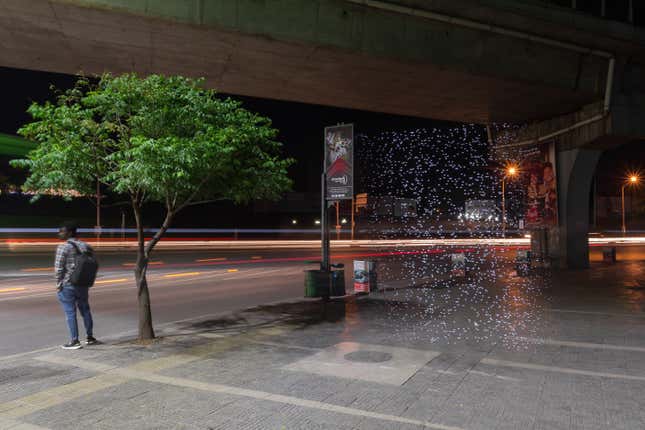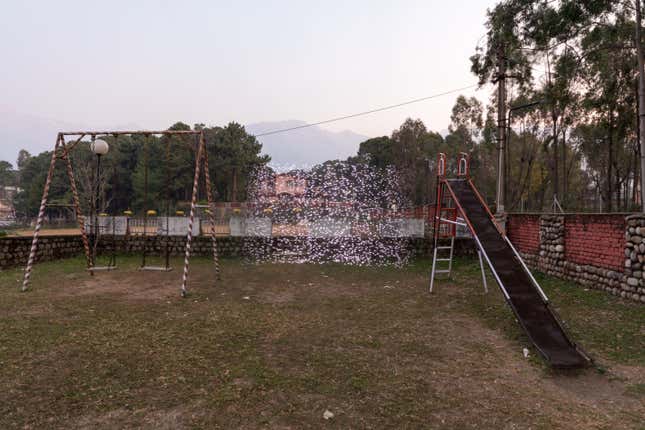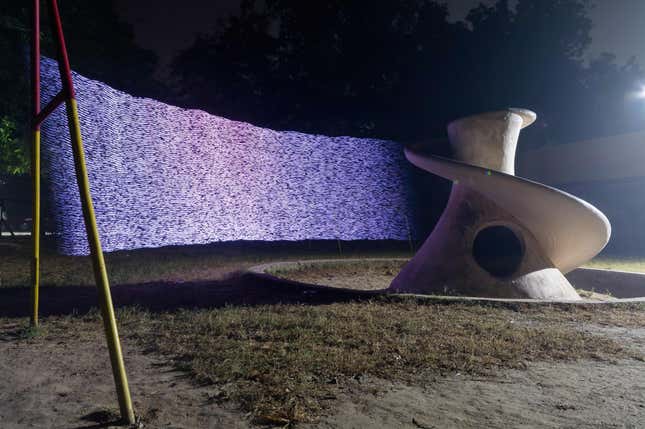The ugly reality is that if you happen to may see the standard of the air you breathe in lots of locations, you would not go outdoors. However it is very important spotlight the insidious presence of air air pollution. Lately, a staff of scientists and artists got here collectively to do exactly that.
Photographs taken by the Anthropocene Air Venture present the ever present presence of particulate matter world wide. Particulate matter may be very small – it floats within the air, so maybe it is apparent – however the staff has developed nifty expertise to detect their presence. The staff created arrays of light-emitting diodes (LEDs) that have been programmed to blink primarily based on the mass focus of particulate matter. Primarily, the dirtier the air, the extra the array will glow. The staff then took lengthy publicity images of the scenes, creating “mild work” that highlighted the place the air was at its worst.
The staff photographed places within the UK, Ethiopia and India, displaying how poor air high quality is even in surprising locations. His analysis was printed final week in Connection Earth and atmosphere.
“As a staff, we have been actually eager to do extra than simply present folks the issue of air pollution with out giving recommendation on easy methods to change their publicity,” Francis Pope, an environmental scientist on the College of Birmingham and lead writer of the research, mentioned in an electronic mail to Gizmodo. “That is why within the Ethiopia marketing campaign we used mild work as a strategy to generate curiosity and dialogue. We printed mild work on postcards together with detailed data on easy methods to scale back air air pollution and your affect on it.”

“We (Robin and Francis) have been working collectively on visualizing air air pollution since 2017, this mission was an incredible studying expertise and we have now repeated this strategy,” mentioned Robin Worth, an artist and writer who co-authored the current paper. in an electronic mail to Gizmodo. “The primary {photograph} proven within the article is of the Port Talbot steelworks in Wales, which was chosen resulting from residents’ issues about this big industrial web site. Since that first job, we have now continued to work in numerous places world wide.”
The sunshine portray of Port Talbot is above. In keeping with the World Well being Group, 99% of world air pollution comes from polluted air, and about 7 million untimely deaths yearly may be attributed to air air pollution. WHO additionally states widespread sources of air air pollution: family heating units, vehicles, industrial services and forest fires.

The picture above reveals a well-developed a part of Addias Abib, the capital of Ethiopia. The staff measured particulate matter concentrations starting from 10 to twenty micrograms per cubic meter—comparatively low in comparison with main cities world wide. However once you examine it to the picture of an indoor city kitchen (on the high of the article), the place concentrations have been about 20 instances increased than outdoor, it turns into clear that the results of air air pollution can differ tremendously even amongst individuals who reside or work. comparatively shut to one another.
Maybe essentially the most memorable within the sequence have been two mild work made in Indian playgrounds. The playgrounds have been positioned in Palampur and Delhi, greater than 300 miles (500 kilometers) aside. The Delhi playground had about 12.5 instances extra particulate matter within the air than the Palampur playground.
The mission has been exhibited in Los Angeles, Belfast and Birmingham, and the staff is now open-sourcing the mission, permitting scientists world wide to create their very own mild work. Final 12 months, cooperation with EUniWell introduced mild work in Leidendemonstrating the adaptability of the mission.
Ignorance is bliss till you harm your lung. Seeing air air pollution illuminated by lights is a stark reminder of its ubiquity and the way it poses a severe menace to human well being—regardless of the place you might be on the planet.
Extra: World’s first air pollution-related demise may spark the change we want


